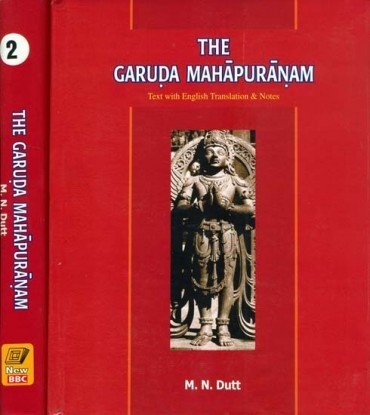The Garuda Purana
by Manmatha Nath Dutt | 1908 | 245,256 words | ISBN-13: 9788183150736
The English translation of the Garuda Purana: contents include a creation theory, description of vratas (religious observances), sacred holidays, sacred places dedicated to the sun, but also prayers from the Tantrika ritual, addressed to the sun, to Shiva, and to Vishnu. The Garuda Purana also contains treatises on astrology, palmistry, and preci...
Chapter XCIII - Laws of virtue as promulgated by the holy Yajnavalkya
Maheshvara said:—Tell me, O Hari, O Madhava, O you who have destroyed the demon Keshi, what is it that led the holy Yajnavalkya, to lay down the rules of conduct in days of yore?
Said the god Hari:—Once on a time, the holy sages visited, in a body, the venerable Yajnavalkya in his hermitage at Mithila; and having duly made obeisance to him, they asked him about the rules of conduct to be observed by members of the different orders of society. Whereupon the self-controlled Yajnavalkya, meditating upon the self of Vishnu, replied as follows.
Yajnavalkya said:—Pious is the country where herds of black deer are found to roam about. Knowledge is in the Vedas, in the Puranas, in the different schools of philosophy such as the Nyaya, the Mimansa, etc., in the Dharma Shastras (Ethics and Social Economy) and in the books of money-making and temporal sciences: Manu, Vishnu, Yama, Angira, Vashishtha, Daksha, Samvarta, Shatatapa. Parashara, Apastambha, Ushana, Vyasa, Katyayana, Vrihaspati. Gautama, Shankha, Likhita, Harita, and Atri, are the names of the fourteen holy sages, who, having worshipped the god Vishnu, were enabled to become the ethical dictators and law-givers (Dharma-Shashtrakaras) of the ages in which they lived.
A gift, made at a proper time and place, and to a deserving person in a true spirit of compassionate sympathy, carries, the merit of all sorts of pious acts. Right conduct, self-control, charity, annihilation of all killing propensities, reading of the Vedas, and the performance of ceremonial rites therein, enjoined to be performed, are the best of all pieties. Viewing of one’s own soul through self-communion, is the highest and most imperative of all religious duties. The four Vedas together with the Trividyas form the branch of learning which is called the Para-Vidya (Supreme knowledge.)
The first three of the four social orders of Brahmana, Kshatriya, Vaishya and Shudra, are called the twice-born castes, and all rites, from nativity to death, should be done unto them in the accompaniment of the Vedic hymns and verses.
The rite of Garbhadhanam (lit., rite for the taking of the womb) should be performed closely following upon the appearance of her first menses unto one’s wife, and the rite of Punsavanam (rite for the conception of a male-child) just as soon as the movements of the foetus in the womb would be felt by the mother. The rite of Sisanta should be done unto her in the sixth or in the eighth month of gestation, while the post-natal rites (Jatakarma) of the new-born babe should be performed after delivery.
The rite of naming (Nama-karanam) should be done unto the child on the eleventh day of its birth, while the rite of Nishkramanam (ceremonial taking of the child out of the room) should be done unto it, in the fourth month after delivery. The rite of Annaprashanam (first taking of boiled-rice by a child) should be done in the sixth month after its birth, while the rite of Chuda-karanam (tonsure) should be performed in accordance with the custom obtaining in the family. The sin, which attaches to the ovum and the semen, is absolved by the performance of the aforesaid rites, which should be omitted in the case of a female child, only on the occasion of whose marriage the Vedic Mantras should be recited.
